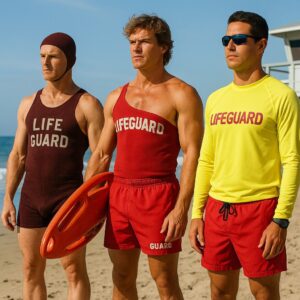The lifeguard is one of those rare figures who seems to exist both in the periphery of our awareness and in the very heart of our sense of safety at the beach or pool. They’re there before the first towels hit the sand, scanning the horizon, and still there when the last stubborn swimmer reluctantly leaves the water. Over time, the image of the lifeguard—watchful, sun-kissed, and somehow a blend of casual relaxation and acute readiness—has evolved alongside the places they protect. But perhaps nothing tells the story of this transformation better than the changing uniforms they’ve worn through the decades.
The concept of a lifeguard dates back far earlier than many realize. In the 18th and early 19th centuries, there were no standardized uniforms, no organized forces patrolling the water’s edge. Early “lifeguards” were often local fishermen, sailors, or strong swimmers who happened to be nearby when trouble struck. Their “uniform” was whatever they wore that day—often heavy, impractical clothing that would make rescues even harder. Saving lives was a matter of instinct, courage, and proximity, not profession.
By the mid-to-late 1800s, the emergence of public bathing beaches and seaside resorts brought new challenges. Crowds of inexperienced swimmers needed watching, and communities began to formally hire beach patrols. In these early organized days, uniforms were minimal but symbolic—simple sashes, armbands, or caps to identify the lifeguard. The intention wasn’t fashion, but recognition: in an emergency, the rescuer needed to be immediately visible.
The early 20th century marked a significant turning point. Lifeguarding was becoming a profession, with training standards, rescue techniques, and official organizations. Uniforms shifted toward functionality—sleeveless wool swimwear for mobility in the water, with bright colors (often red or white) to stand out against the surf. Caps and tank-style swim shirts were common, both for sun protection and quick identification. The look was modest by modern standards, but it reflected the era’s swimwear trends and the need for practicality.
By the 1920s and 1930s, lifeguard uniforms were heavily influenced by competitive swimwear. One-piece tank suits for men, sometimes belted, and streamlined women’s suits replaced the heavy wool. Shorts became more common for male guards on shore duty, paired with sleeveless tops emblazoned with “LIFEGUARD” in bold lettering. This was also the period when lifeguard towers became more common fixtures, and uniforms needed to be comfortable for long shifts in the sun while remaining ready for sudden rescues.
The post-WWII era brought not only a boom in beach culture but also a shift toward the image of the lifeguard as an emblem of vitality and athleticism. Advances in fabric technology introduced lighter, quick-drying materials. Swim trunks for men grew shorter, and female lifeguards—still fewer in number—wore one-piece suits with brighter designs. The red-and-white color scheme began to dominate, thanks to its high visibility and the influence of rescue organizations worldwide.
In the 1960s and 1970s, surf culture began to shape the lifeguard aesthetic. In California, Australia, and Hawaii especially, lifeguards embodied the laid-back beach lifestyle, blending athleticism with an easy cool. Board shorts, sun-bleached hair, and reflective sunglasses became part of the unofficial “uniform” for many male guards, while female guards often adopted athletic bikinis or practical one-pieces paired with shorts. The rescue can (also known as the torpedo buoy) became a recognizable accessory—both a vital rescue tool and a symbol of authority on the sand.
The 1980s and early 1990s marked the explosion of lifeguard imagery into global pop culture. Television shows like Baywatch cemented the stereotype of the lifeguard as glamorous, perpetually tanned, and outfitted in form-fitting red swimwear. The slow-motion run down the beach became iconic, and the uniform—a high-cut red swimsuit for women, red shorts for men—was as much about branding as safety. While real lifeguards may have rolled their eyes at Hollywood dramatics, the impact was undeniable: the “lifeguard look” became a fashion trend in its own right, even away from the water.
But real lifeguards continued to adapt their uniforms with safety and practicality in mind. The late 1990s and 2000s brought lightweight rash guards for sun protection, moisture-wicking fabrics, and more standardized gear depending on region and climate. High-visibility colors remained key—red, yellow, and orange dominating in different parts of the world. Caps, visors, and polarized sunglasses became standard to reduce glare during long hours of scanning the water.
The modern lifeguard uniform is a careful balance between visibility, comfort, and utility. Many now include official logos, emergency whistle attachments, and quick-access pockets for small rescue gear. In some locations, guards switch between swimwear and more covered uniforms depending on weather and duty—board shorts and shirts for patrolling, streamlined suits for rescue swims. Technology has also crept in, with waterproof radios and even body cameras in some cases.
Importantly, the evolution of the lifeguard uniform mirrors the evolution of the profession itself. Once a loosely organized job for strong swimmers, it’s now a rigorous, highly trained role requiring certification in CPR, first aid, and specialized rescue techniques. The uniform signals authority, professionalism, and readiness. It also serves as a visible reminder to the public: someone is watching, prepared to act when seconds matter.
Yet, despite all the changes, the core image of the lifeguard hasn’t lost its timeless appeal. Whether it’s the stoic figure in a watchtower, the sprinter racing down the shore with a rescue can, or the calm rescuer guiding someone to safety, the lifeguard remains a reassuring presence. And their uniform—whether wool tank suit, red board shorts, or high-tech rash guard—tells a silent story about the era, the culture, and the shared human need to protect each other in the unpredictable meeting place between land and water.
From the beaches of Sydney to the shores of California, from lakeside camps to Olympic swimming venues, the lifeguard’s attire is more than fabric—it’s a flag of safety, an emblem of trust, and, in its own way, a piece of living history.
































